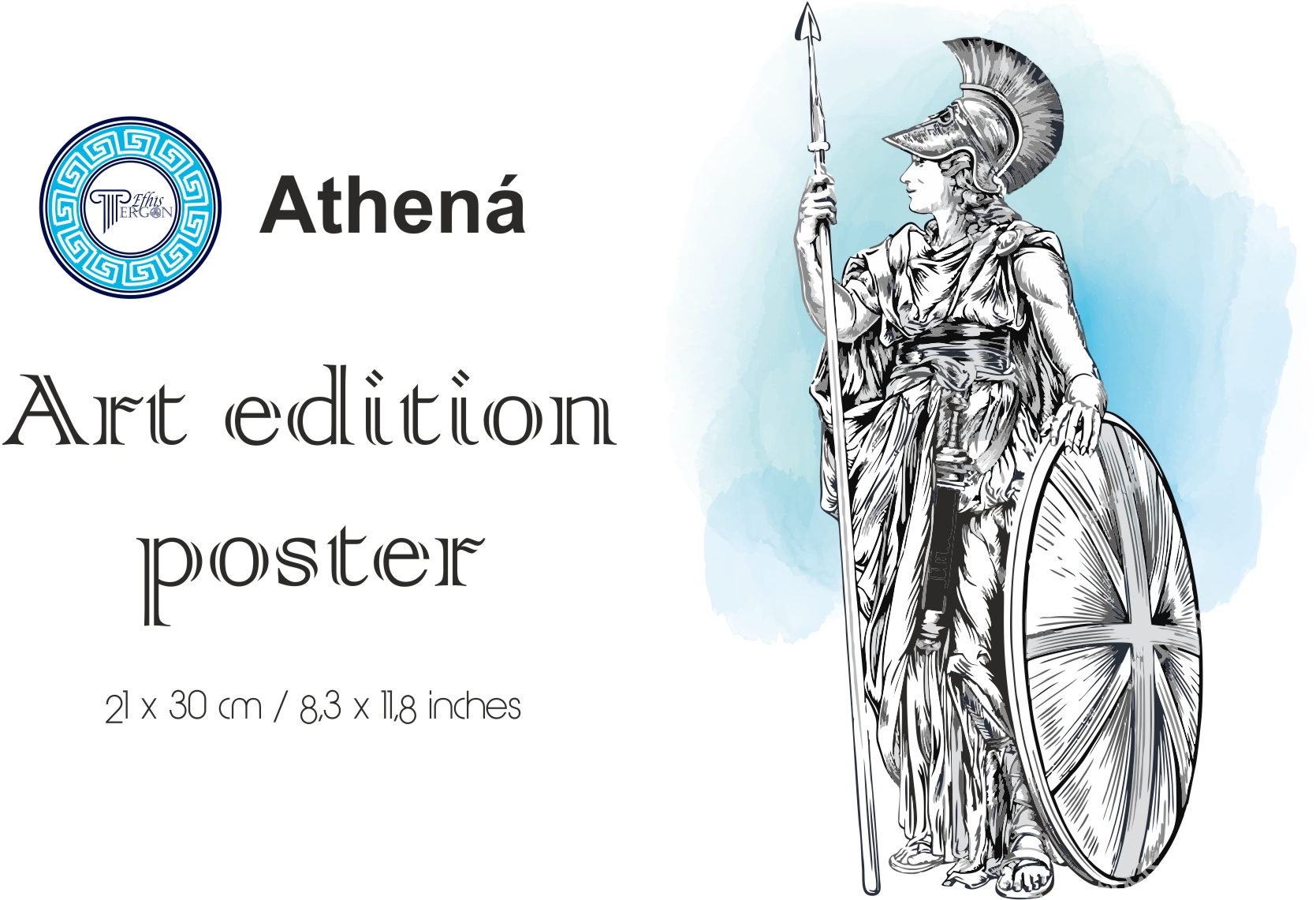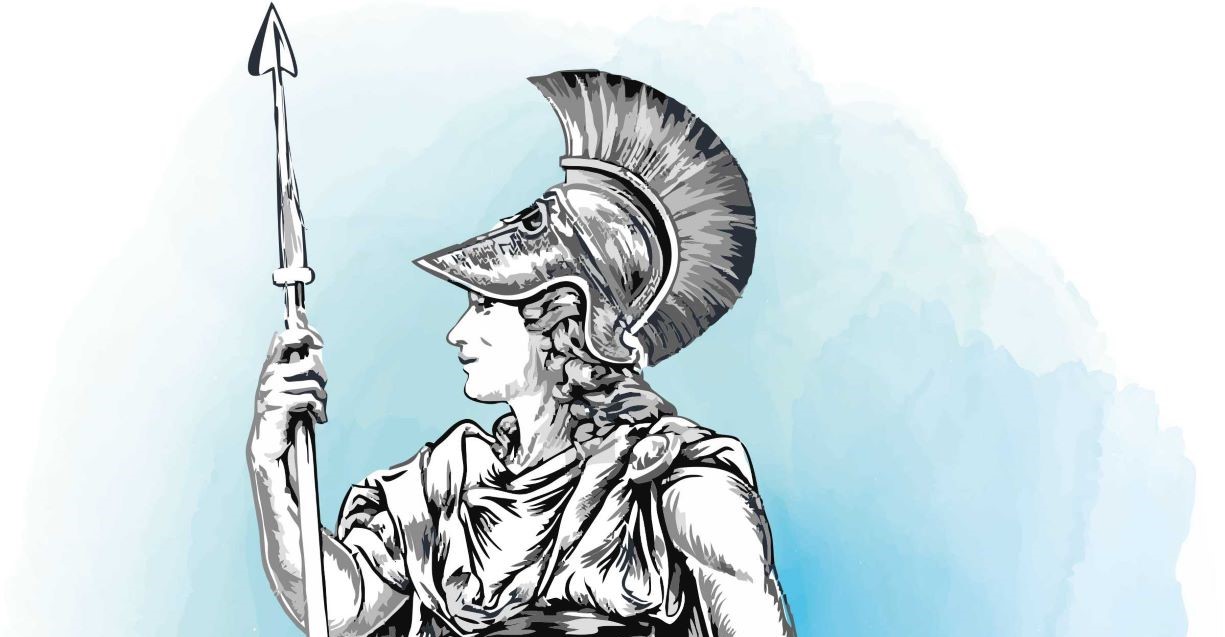
Η Αθηνά είναι αρχαία ελληνική θεά που σχετίζεται με τη σοφία, τη χειροτεχνία και τον πόλεμο.
Η Αθηνά θεωρούνταν προστάτιδα διαφόρων πόλεων σε όλη την Ελλάδα, ιδιαίτερα της Αθήνας, από την οποία πιθανότατα πήρε το όνομά της.
Σε αυτήν είναι αφιερωμένος ο Παρθενώνας στην Ακρόπολη των Αθηνών. Τα κυριότερα σύμβολά της περιλαμβάνουν κουκουβάγιες, ελιές, φίδια και το Γοργόνειο. Στην τέχνη, γενικά απεικονίζεται να φοράει κράνος και να κρατά δόρυ.
Από την καταγωγή της ως θεά των ανακτόρων του Αιγαίου, η Αθηνά ήταν στενά συνδεδεμένη με την πόλη. Ήταν γνωστή ως Πολιούχος και οι ναοί της βρίσκονταν συνήθως στην κορυφή της οχυρωμένης ακρόπολης στο κεντρικό τμήμα της πόλης.
Ο Παρθενώνας στην Αθηναϊκή Ακρόπολη είναι αφιερωμένος σε αυτήν, μαζί με πολλούς άλλους ναούς και μνημεία.
Ήταν επίσης θεά πολεμίστρια και πίστευαν ότι οδηγούσε στρατιώτες στη μάχη ως Αθηνά Πρόμαχος.
Το κυριότερο πανηγύρι της στην Αθήνα ήταν τα Παναθήναια, που γιορτάζονταν κατά τον μήνα Εκατομβάιον στα μέσα του καλοκαιριού και ήταν η σημαντικότερη γιορτή του αθηναϊκού ημερολογίου.
Στην ελληνική μυθολογία, η Αθηνά πιστεύεται ότι γεννήθηκε από το μέτωπο του πατέρα της Δία.
Στον ιδρυτικό μύθο της Αθήνας, η Αθηνά κέρδισε τον Ποσειδώνα σε έναν ανταγωνισμό για την προστασία της πόλης δημιουργώντας την πρώτη ελιά. Ήταν γνωστή ως Αθηνά Παρθένος «Αθηνά η Παρθένος», αλλά σε έναν αρχαϊκό αττικό μύθο, ο θεός Ήφαιστος προσπάθησε και απέτυχε να τη βιάσει, με αποτέλεσμα η Γαία να γεννήσει τον Εριχθόνιο, έναν σημαντικό Αθηναίο ιδρυτικό ήρωα.
Athená is an ancient Greek goddess associated with wisdom, handicraft, and warfare.
Athena was regarded as the patron and protectress of various cities across Greece, particularly the city of Athens, from which she most likely received her name.
The Parthenon on the Acropolis of Athens is dedicated to her. Her major symbols include owls, olive trees, snakes, and the Gorgoneion. In art, she is generally depicted wearing a helmet and holding a spear.
From her origin as an Aegean palace goddess, Athena was closely associated with the city. She was known as Poliouchos and her temples were usually located atop the fortified acropolis in the central part of the city.
The Parthenon on the Athenian Acropolis is dedicated to her, along with numerous other temples and monuments.
She was also a warrior goddess, and was believed to lead soldiers into battle as Athena Promachos.
Her main festival in Athens was the Panathenaia, which was celebrated during the month of Hekatombaion in midsummer and was the most important festival on the Athenian calendar.
In Greek mythology, Athena was believed to have been born from the forehead of her father Zeus.
In the founding myth of Athens, Athena bested Poseidon in a competition over patronage of the city by creating the first olive tree. She was known as Athena Parthenos “Athena the Virgin,” but in one archaic Attic myth, the god Hephaestus tried and failed to rape her, resulting in Gaia giving birth to Erichthonius, an important Athenian founding hero.
Athéna est une ancienne déesse grecque associée à la sagesse, à l’artisanat et à la guerre.
Athéna était considérée comme la protectrice et la protectrice de diverses villes de Grèce, en particulier d’Athènes, dont elle a probablement tiré son nom.
Le Parthénon de l’Acropole d’Athènes lui est dédié. Ses principaux symboles sont les hiboux, les olives, les serpents et la Gorgone. Dans l’art, il est généralement représenté coiffé d’un casque et tenant une lance.
De ses origines de déesse des palais de la mer Egée, Athéna était étroitement associée à la ville. Elle était connue sous le nom de Poliuchos et ses temples étaient généralement situés au sommet de la citadelle fortifiée dans la partie centrale de la ville.
Le Parthénon de l’Acropole d’Athènes lui est dédié, ainsi que de nombreux autres temples et monuments.
Elle était également une déesse guerrière et était censée mener les soldats au combat sous le nom d’Athéna Promachos.
Son festival principal à Athènes était le Panathenaia, qui était célébré pendant le mois d’Hekatomvaion au milieu de l’été et était le festival le plus important du calendrier athénien.
Dans la mythologie grecque, Athéna serait née du front de son père Zeus.
Dans le mythe fondateur d’Athènes, Athéna a battu Poséidon dans un concours pour protéger la ville en créant le premier olivier. Elle était connue sous le nom d’Athéna Parthénos “Athéna la Vierge”, mais dans un mythe attique archaïque, le dieu Héphaïstos a essayé et échoué de la violer, ce qui a amené Gaia à donner naissance à Erichthonius, un important héros fondateur athénien.
Athéna es una antigua diosa griega asociada con la sabiduría, la artesanía y la guerra.
Atenea era considerada protectora y protectora de varias ciudades de Grecia, especialmente de Atenas, de donde probablemente tomó su nombre.
A él está dedicado el Partenón de la Acrópolis de Atenas. Sus principales símbolos son los búhos, los olivos, las serpientes y la Gorgona. En el arte, generalmente se lo representa con un casco y sosteniendo una lanza.
Desde sus orígenes como diosa de los palacios del Egeo, Atenea estuvo estrechamente asociada a la ciudad. Era conocido como Poliuchos y sus templos solían estar ubicados sobre la ciudadela fortificada en la parte central de la ciudad.
A él está dedicado el Partenón de la Acrópolis de Atenas, así como muchos otros templos y monumentos.
También era una diosa guerrera y se creía que conducía a los soldados a la batalla como Athena Promachos.
Su fiesta principal en Atenas era la Panathenaia, que se celebraba durante el mes de Hekatomvaion en pleno verano y era la fiesta más importante del calendario ateniense.
En la mitología griega, Atenea nació de la frente de su padre Zeus.
En el mito fundacional de Atenas, Atenea derrotó a Poseidón en un concurso para proteger la ciudad creando el primer olivo. Se la conocía como Athena Parthenos “Athena the Virgin”, pero en un mito ático arcaico, el dios Hefesto intentó y fracasó en violarla, lo que provocó que Gaia diera a luz a Erichthonius, un importante héroe fundador ateniense.
Athéna ist eine antike griechische Göttin, die mit Weisheit, Handwerk und Krieg in Verbindung gebracht wird.
Athena galt als Patronin und Beschützerin verschiedener Städte Griechenlands, insbesondere Athens, von dem sie wahrscheinlich auch ihren Namen hat.
Ihm ist der Parthenon auf der Akropolis in Athen gewidmet. Die Hauptsymbole von ihr sind Eulen, Olivenbäume, Schlangen und die Gorgone. In der Kunst wird er normalerweise mit einem Helm und einem Speer dargestellt.
Seit ihrer Herkunft als Göttin der ägäischen Paläste war Athena eng mit der Stadt verbunden. Er war als Poliuchos bekannt und seine Tempel befanden sich früher über der befestigten Zitadelle im zentralen Teil der Stadt.
Der Parthenon der Akropolis von Athen ist ihm gewidmet, ebenso wie viele andere Tempel und Denkmäler.
Sie war auch eine Kriegergöttin und es wurde angenommen, dass sie Soldaten wie Athena Promachos in die Schlacht führte.
Ihr Hauptfest in Athen war die Panathenaia, die während des Monats Hekatomvaion im Hochsommer gefeiert wurde und das wichtigste Fest im Athener Kalender war.
In der griechischen Mythologie wurde Athena aus der Stirn ihres Vaters Zeus geboren.
Im Gründungsmythos von Athen besiegte Athena Poseidon in einem Wettbewerb zum Schutz der Stadt, indem sie den ersten Olivenbaum schuf. Sie war als Athena Parthenos “Athena die Jungfrau” bekannt, aber in einem archaischen attischen Mythos versuchte der Gott Hephaistos, sie zu vergewaltigen, und scheiterte, was dazu führte, dass Gaia Erichthonius, einen wichtigen Athener Gründungshelden, zur Welt brachte.
The median team leaves the fold of the groin, while the lateral team is located further out in the direction of uromexil forte pro ženy the thigh.

